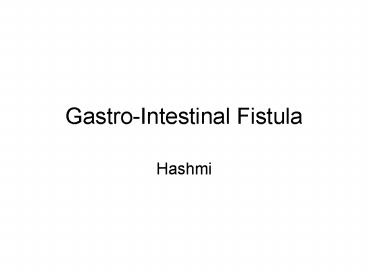Gastro-Intestinal Fistula - PowerPoint PPT Presentation
1 / 9
Title:
Gastro-Intestinal Fistula
Description:
Gastro-Intestinal Fistula Hashmi Fistulas are abnormal communications between two epithelial-lined surfaces Gastrointestinal (GI) fistulas represent abnormal ductlike ... – PowerPoint PPT presentation
Number of Views:747
Avg rating:3.0/5.0
Title: Gastro-Intestinal Fistula
1
Gastro-Intestinal Fistula
- Hashmi
2
- Fistulas are abnormal communications between two
epithelial-lined surfaces - Gastrointestinal (GI) fistulas represent abnormal
ductlike communications between the gut and
another epithelial-lined surface - organ system
- skin surface
- GI tract itself
3
(No Transcript)
4
- The majority of external (cutaneous) fistulas
represent a complication of recent abdominal
surgery - The leading causes of internal fistulas
- Crohn disease
- Diverticulitis
- Malignancy
- Complication of treatment
5
- F Foreign Body
- R Radiation
- I IBD / Infection
- E Epithelialized tract
- N Neoplasm
- D Distal Obstruction
- S Segment (gt2cm)
6
- High output fistula are from upper GI tract
- High-output GI fistula discharge more than
500ml/day - High-output pancreatic fistula is one which
produces more than 200 ml/day - High output fistula
- more serious metabolic disturbances
- higher mortality rates
7
- Spontaneous closure
- bowel continuity is maintained
- no abscess
- adjacent bowel is healthy
- no distal obstruction
- fistula tract is not epithelialized
- not more than 2 cm in length
- bowel defect is less than 1 cm in diameter
- Least likely to close with non-operative therapy
- gastric
- lateral duodenal
- ligament of Treitz
- ileal fistula
8
- Nutritional Support
- Minerals, vitamins, electrolytes
- Caloric intake (35-45 cal/kg/day)
- Protein (1.5-1.75 gm/kg/day)
- TPN
9
- Recognition and Stabilization
- fluid resuscitation, electrolytes, acid/base
balance, control of sepsis, local wound care,
nutritional support - Investigation and Assessment
- radiological
- source, nature of tract, bowel continuity,
obstruction, adjacent bowel, abscess - Definitive Treatment
- somatostatin and nutritional support, surgical
resection /- diversion































